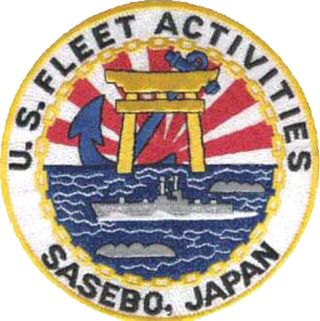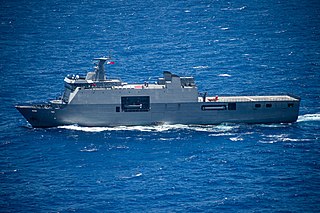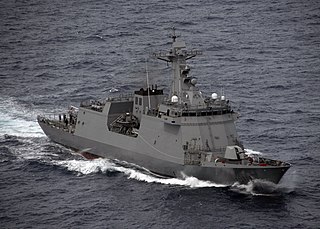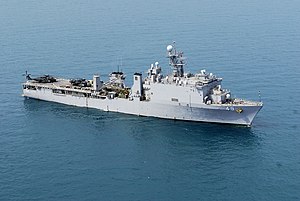
USS New Orleans (LPD-18), a San Antonio-class amphibious transport dock, is the fourth commissioned ship of the United States Navy to be named after the city of New Orleans, Louisiana.

USS Denver (LPD-9), an Austin-class amphibious transport dock, was the third ship of United States Navy to bear this name. Denver's keel was laid on 7 July 1964 at Lockheed Shipbuilding and Construction Company, Seattle, Washington. She was launched on 23 January 1965, christened by Mrs. Ann Daniels Love, wife of John A. Love, the former governor of Colorado, and commissioned on 26 October 1968. After 46 years of service, Denver was decommissioned at Joint Base Pearl Harbor–Hickam on 14 August 2014. At the time of her decommissioning, Denver was the oldest deployable warship in the U.S. Navy, and was one of the last active warships to have served in Vietnam.

USS Curts (FFG-38) was the twenty-ninth ship of the Oliver Hazard Perry-class of guided-missile frigates. She was named for Admiral Maurice Curts (1898–1976). Curts is the first ship of that name in the US Navy.

USS Germantown (LSD-42) is the second Whidbey Island-class dock landing ship in the United States Navy. She is the second navy ship named after the Revolutionary War Battle of Germantown.

U.S. Fleet Activities Sasebo is a United States Navy base, in Sasebo, Japan, on the island of Kyūshū. It provides facilities for the logistic support of forward-deployed units and visiting operating forces of the United States Pacific Fleet and designated tenant activities.

USS Fort McHenry (LSD-43) is a Whidbey Island-class dock landing ship of the United States Navy. She was named for Fort McHenry, in Baltimore, Maryland, the 1814 defense of which inspired "The Star-Spangled Banner".

USS Tortuga (LSD-46) is a Whidbey Island-class dock landing ship of the United States Navy. She was the second Navy ship to be named for the Dry Tortugas, a group of desert coral islets 60 miles (97 km) west of Key West, Florida.

USS Rushmore (LSD-47) is a Whidbey Island-class dock landing ship of the United States Navy. She was the second navy ship to be named for the Mount Rushmore National Memorial in the Black Hills of South Dakota. She is the seventh ship in her class of dock landing ships and the fourth ship in that class to serve in the United States Pacific Fleet.

Vendémiaire is a Floréal-class frigate of the French Navy. She is the fifth ship of the class, and is named after Vendémiaire, the first month of the Republican Calendar. The ship was constructed at Saint-Nazaire, France, in 1992 and entered service in 1993. Vendémiaire is stationed in the French Pacific territories for patrol duties.

The BRP Dagupan City (LS-551) is the second and last ship of two Bacolod City class logistics support vessel, and is based on a helicopter capable variant of the US Army Frank S. Besson class. She is also considered one of the most modern transport ships in the Philippine Navy, having been commissioned during the early 1990s. She was previously known as BRP Dagupan City (LC-551) prior to a classification change implemented by the Philippine Navy starting April 2016

The BRP Rajah Humabon (PS-11) was a former destroyer escort of the United States Navy and a former frigate of the Philippine Navy. She was the last World War II-era destroyer escort/frigate active in her fleet, and one of the oldest active warships in the world, until 15 March 2018 when she was formally decommissioned after 75 years. She was one of three ex-USN Cannon-class destroyer escorts that served the Philippine Navy, the others being BRP Datu Sikatuna (PF-5/PS-77) and BRP Datu Kalantiaw (PS-76).

The BRP Rizal (PS-74) was the lead ship and first of two Rizal class ships in service with the Philippine Navy. She was an ex-USN Auk class minesweeper that was produced during World War II, and was classified as a patrol corvette protecting the vast waters of the Philippines. Along with other ex-World War II veteran ships of the Philippine Navy, she was considered one of the oldest active fighting ships in the world, until 2020.

BRP Cebu (PS-28) was a Miguel Malvar-class corvette of the Philippine Navy. She was originally built as USS PCE-881, a PCE-842-class patrol craft for the United States Navy during World War II and patrolled the Alaskan coast during that war. She was decommissioned from the U.S. Navy and transferred to the Philippine Navy in July 1948 and renamed RPS Cebu (E-28) after the Philippine province of the same name. The ship was decommissioned on 1 October 2019. Along with other World War II-era ships of the Philippine Navy, Cebu was considered one of the world's oldest fighting ships during her active service.

BRP Pangasinan (PS-31) was a Miguel Malvar-class corvette of the Philippine Navy. She was originally built as USS PCE-891, a PCE-842-class patrol craft for the United States Navy during World War II. She was decommissioned from the U.S. Navy and transferred to the Philippine Navy in July 1948 and renamed RPS Pangasinan (E-31).

Expeditionary Strike Group SEVEN/Task Force 76 is a United States Navy task force. It is part of the United States Seventh Fleet and the USN's only permanently forward-deployed expeditionary strike group. It is based at the White Beach Naval Facility at the end of the Katsuren Peninsula in Uruma City, Okinawa, Japan.

BRP Tarlac (LD-601) is the lead ship of her class of landing platform docks in service with the Philippine Navy. She is the second ship to be named after the Philippine province of Tarlac, one of the provinces considered to have significant involvement in the Philippine Revolution of independence against Spain.

BRP Gregorio del Pilar (PS-15) is the lead ship of her class of offshore patrol vessel of the Philippine Navy. She is the second ship to be named after Gregorio del Pilar, a Filipino revolutionary general known for his role at the Battle of Tirad Pass. She was originally designated as "PF-15" from 2012 to mid-2016. Then the Navy adopted a new code designation system and she was redesignated as "FF-15". In February 2019, the Navy downgraded the status of the entire class from frigate to patrol ship and redesignated her to "PS-15".

BRP Ramon Alcaraz (PS-16) is the second ship of the Gregorio del Pilar-class offshore patrol vessels of the Philippine Navy. From 1968 to 2012, she was known as USCGC Dallas and served the United States Coast Guard as a high endurance cutter. She was decommissioned on 30 March 2012 and acquired by the Philippines under the Excess Defense Articles and the Foreign Assistance Act.

BRP Davao del Sur (LD-602) is the second ship of the Tarlac-class landing platform dock of the Philippine Navy. She is the second ship to be named after the Philippine province of Davao del Sur, one of the main provinces in Mindanao in Southern Philippines. She was launched on 29 September 2016 and was commissioned into service on 31 May 2017.

BRP Jose Rizal (FF-150) is the lead ship of her class of guided missile frigates of the Philippine Navy. She is the first purpose-built frigate of the service, as its previous major warships were mostly obtained from retired patrol ships of other countries. She is also one of the navy's primary warships able to conduct multi-role operations, such as coastal patrol, anti-air and anti-submarine warfare.






















